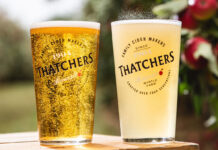Demand for locally-produced gins sees sales in Scotland exceed rest of UK

FOR years now, gin has been the talk of the trade – and with good reason.
Not only has it captured the imaginations of some of the country’s top bartenders – further aiding the category’s reinvigoration – sales of the juniper-led spirit in pubs have skyrocketed; according to William Grant & Sons’ Trending 2020 report, gin could potentially knock vodka off its perch to become the best-selling spirit in the on-trade next year (see p30).
And with gin sales in Scotland outpacing those in the rest of the UK, it makes sense for operators north of the border to carefully consider the brands on their back-bar, drinks companies told SLTN.
Commenting on Scotland leading the gin sales charge, Fiona Walsh, director at Red Castle Spirits, said: “There is a real excitement in the industry and new producers are popping up on a weekly basis.
“With the global brands now proud to use the fact they are made in Scotland as a real positive brand story, Scotland has gained a fantastic reputation for producing some of the world’s best known gins, like Gordon’s, Tanqueray and Hendrick’s.”
I think the most important thing is to sell gin that you and your team are passionate about.
Stephen Kemp, managing director of Orkney Distilling – producer of Kirkjuvagr Gin – reckons that the prevalence of gin distilleries across Scotland continues to play an important role in bolstering sales of the spirit in the country’s on-trade.
He said: “Scotland produces a disproportionate amount of gin in Britain. Often produced in local areas and tied to communities, customers tend to want to enjoy that sense of place and take pride in a local artisan product.”
This was echoed by McQueen Gin’s managing director, Dale McQueen, who said: “Roughly 70% of the UK’s gin is produced in Scotland. We know that Scottish consumers in particular value Scottish provenance highly and actively seek out Scottish products – and we believe this is one of the key drivers of sales in Scotland.”
Similarly, Jill Smith, co-founder of Smithies Gin, said locally-produced gins “are highly sought for due to their unique stories behind making the gins”.
But with so many gins to choose from, how should operators approach a range refresh?
Smith said: “I think the most important thing is to sell the stuff you’re passionate about.
“Operators should look at the story behind the gins, as well as the flavour profiles.”
Meanwhile, Liam Hughes, co-founder of The Glasgow Distillery – producer of Makar Gin – reckons the right range “will look different to every customer”.
“For us as a distillery, a good gin range would keep juniper at the heart of each expression, whilst also displaying experimentation and innovation,” said Hughes.
“This might mean exploring various options with different botanicals, fresh fruit and even maturation in various casks – but in a way that doesn’t compromise the very essence of a juniper-led gin.”
However, while Kemp of Orkney Distilling agreed that a pub’s gin range should be varied, he said that “it is wise to have a reasonably affordable house serve, then a few from the surrounding area”.
He added: “It is now undoubtedly wise to stock pink gin and gin liqueurs, almost in its own category now, and there are dozens of smaller producers offering these.”
Assembling the right range
Stock gins from a variety of locations and offer a raft of styles – London Dry, Navy Strength and so on.
– Orkney Distilling.
Ensure your gin range has structure. Focus on what gins you want to stock – Scottish, international, liqueurs, etc.
– Smithies Gin.
Support local brands, merchandise your gantry by region and/or style to make it easy for the customer to explore your range.
– Red Castle Spirits.
Try to be unique in an ever-growing spirits industry by stocking a range of smaller craft gins that are up and coming.
– Smithies Gin.























